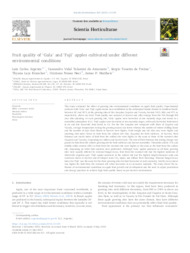Fruit quality of Gala and Fuji apples cultivated under different environmental conditions.
Fruit quality of Gala and Fuji apples cultivated under different environmental conditions.
Author(s): ARGENTA, L. C.; AMARANTE, C. V. T. do; FREITAS, S. T. de; BRANCHER, T. L.; NESI, C. N.; MATTHEIS, J. P.
Summary: This study evaluated the effect of growing site environmental conditions on apple fruit quality. Experimental orchards with ?Gala? and ?Fuji? apple strains were established in the ubtropical humid climate in Southern Brazil, between 26◦ and 28◦S, in the growing sites of S ̃ao Joaquim, Caçador and Vacaria, located 1415, 960, and 971 m, respectively, above sea level. Fruit quality was assessed at harvest and after storage from the 5th through 8th year after planting. At each growing site, ?Gala? apples were harvested at one maturity stage and stored in a controlled atmosphere (CA). ?Fuji? apples were harvested at two maturity stages, with early harvested fruit stored in air and late harvested fruit stored in CA. For the S ̃ao Joaquim site compared with those of Caçador and Vacaria, average temperature during the growing season was lower whereas the number of winter chilling hours and the number of days from bloom to harvest were higher. Fruit weight and red skin area were higher and russeting skin index lower in fruit from the coldest site (S ̃ao Joaquim) for both cultivars. At harvest, flesh firmness and starch index of fruit from the coldest site were higher or the same as those of the warmest sites (Caçador and Vacaria), depending on cultivar and harvest date. The rate of flesh firmness loss during storage was greater in fruit from the coldest growing site for both cultivars and harvest maturities. Titratable acidity (TA) and soluble solids content (SSC) in fruit from the warmest site were higher or the same as the fruit from the coldest site, depending on when fruit analysis were performed. Although ?Gala? apples produced in all three growing sites were equally affected by external fungal decay, fruit from the warmest site had the highest incidence of Glomerella cingulata spot. ?Fuji? apples produced in the coldest site had the highest length/diameter ratio and watercore index at harvest and developed more CO2 injury and diffuse flesh browning. External fungal decay index for ?Fuji? was the same for the three growing sites for fruit harvested at early maturity, but the decay index was higher for fruit from the warmest site when harvested at an advanced maturity. The study shows the influence of environmental conditions on apple fruit growth and development and the need to adjust production and storage practices to achieve high fruit quality based on pre-harvest environment.
Publication year: 2022
Types of publication: Journal article
Unit: Embrapa Semi-arid Region
Observation
Some of Embrapa's publications are published as ePub files. To read them, use or download one of the following free software options to your computer or mobile device. Android: Google Play Books; IOS: iBooks; Windows and Linux: Calibre.
Access other publications
Access the Agricultural Research Database (BDPA) to consult Embrapa's full library collection and records.
Visit Embrapa Bookstore to purchase books and other publications sold by Embrapa.

